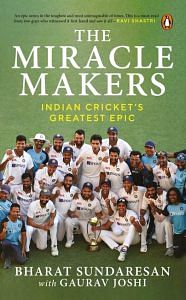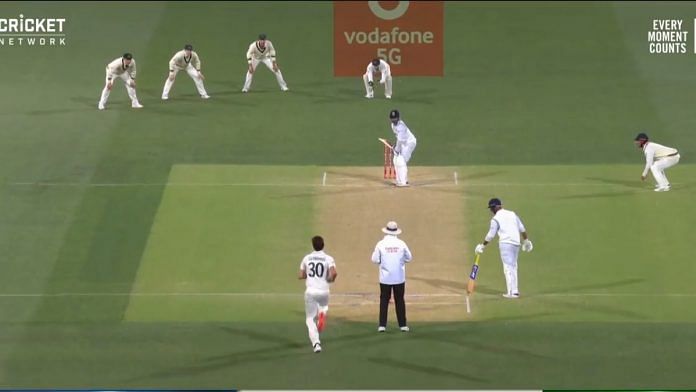Yes, we did look up to see Mayank Agarwal flick a full delivery on his pads from Mitchell Starc for four in the first over. Yes, we did notice Bumrah not making the most of his form in practice and chipping a ball straight back to Pat Cummins in the second over of the day. But apart from a couple of local journalists, nobody else was really in their designated seat to witness these seemingly ancillary events.
Instead, we were split into many huddles at the back, each contemplating the right move to ensure that we neither got held back in Adelaide nor ended up missing Melbourne. For some it was simply a question of not being put in a position where they’d have to miss Christmas with family. It helped that the three overs that followed Bumrah’s dismissal were largely uneventful. Then Cheteshwar Pujara walked out to bat. Surely, Pujara would occupy the crease for a while and let us figure out our next plan of action.
But then off went Pujara, followed right after by Agarwal and Ajinkya Rahane in the same over. India’s score suddenly read 15/5. It was only at that point that the hullabaloo in the press box paused briefly as everyone took a deep breath. It was like there was a collective gasp of, ‘Wait, is this really happening?’ Before anyone could even wrap their heads around it, Kohli was out too. 19/6.
The Indian captain had been surprisingly jittery in this innings, especially in comparison to how sublime he’d looked in the first innings. Maybe, you thought, he had come out with a counterattack in mind. There was nearly an outside edge, an inside edge and a wafty boundary past Cameron Green at gully. Then the flash at a sucker ball wide of the off stump from Pat Cummins, with Green holding on to the catch for dear life. For the second time in three days, Kohli walked back towards the dressing room shaking his head in disbelief. This time, though, he also looked a little shellshocked. He wasn’t the only one. We all were.
We’d all witnessed collapses before, but this was different. There were no plays and misses. Only edges and catches. It felt like we’d been transported into a batter’s fever dream. It was seam bowling of the highest order, yes. And Pat Cummins and Josh Hazlewood are certain to go down as among the greatest fast bowlers Australia has ever produced. But even they couldn’t be so good. Even they couldn’t possibly be so unrelenting as to not even let the batter have the satisfaction of being beaten but still having survived. Even they couldn’t be producing spells where the batters were made to look so far out of their depth. They were doing all this, though. The Indians weren’t just being humbled, they were being decimated.
In the space of 20–25 minutes, the cricketing conversations in the media centre had gone from what kind of target India might set for the home team to whether they could go past the dreaded figure of 26, the lowest Test total of all time. Thankfully, the 7-run partnership between Hanuma Vihari and Saha at least took India on par with that mythical number.
It was around then that Sunil Gavaskar, who was here as a commentator for Channel 7, walked out of the box to inquire about India’s lowest total in Test cricket. He’d been the key figure of the batting line-up that had succumbed to 42 at Lord’s on 20 June 1974. You couldn’t blame him for hoping that this embarrassing statistic—India’s lowest Test total—would no longer be associated with him.
Almost on cue, Saha and R. Ashwin were dismissed off two consecutive deliveries. 26/8.
If there ever was a possibility for a batter to get timed out in a Test match, this had to be it. This was the closest you’d get to a batting innings being played out on a conveyor belt. Not to forget that there was but a single review taken, when Ashwin felt like he hadn’t edged Hazlewood to Tim Paine behind the stumps. Somehow there wasn’t even a single delay, in terms of the batter getting to the crease and marking his guard punctually. Maybe they were in a daze.
Despite the ridiculous score, the stage was set for that inevitable late-order partnership—the kind where the tailenders start edging through gaps and the specialist batter gets a couple of boundaries away. But on this bizarre day, even that wasn’t to be. And the insult would end with a terrible injury.
On most days, Mohammed Shami is your classic old-school tailender who prefers getting away from the line of the ball and then swinging his bat at it. That’s what he was trying to do here. But Cummins was following him. Shami responded to the first short ball with an untoward swat while on his haunches. He responded in a similar fashion to the next one. Unfortunately, it left him locked up awkwardly, with no room to escape. And when the ball smashed into his right forearm, you knew that was it for Shami. Physio Nitin Patel, who would end up as the unsung hero of the tour, tried everything he could, from taping the arm to using the spray. To Shami’s credit, he did seem intent on staying out in the middle. But the fact that he couldn’t hold or pick up his bat made his efforts to do so rather futile. India’s nightmare had come to a painful end, with the enforcer of their bowling attack seemingly having been knocked out of the equation. A few minutes later this was confirmed, as Shami left the Adelaide Oval with his arm in a sling.
It read 36/9 on the historic scoreboard at the Cathedral End. It was unfathomable. What had just happened here? Gaurav and I walked all the way across the oval to pose for a selfie in front of the scoreboard at the end of the day. We simply had to. Surely, this was a kind of cricketing anomaly we’d never get to witness again.
 This excerpt from The Miracle Makers has been published with permission from Penguin Random House India.
This excerpt from The Miracle Makers has been published with permission from Penguin Random House India.



